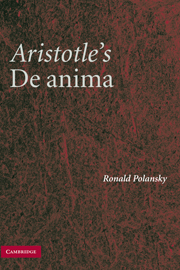Book contents
- Frontmatter
- Contents
- Preface
- List of Abbreviations
- Introduction
- COMMENTARY ON DE ANIMA: : Book 1
- COMMENTARY ON DE ANIMA: Book 2
- 1 Definition of Soul
- 2 What Is Life?
- 3 How Powers of Soul Are Distributed and United in the Soul
- 4 The Nutritive Faculty: Its Object and Subfaculties
- 5 Clarification of Being Affected, Living as Saving, and the First Definition of Sense
- 6 The Three Sorts of Sensible Objects
- 7 Vision, Medium, and Object
- 8 Hearing, Sound, and Voice
- 9 Smell and Odor
- 10 Taste Is a Contact Sense; the Tasteable
- 11 Touch, the Tangibles, and Sense as a Mean
- 12 Definition of Sense and Whether Sensibles Affect Nonperceiving Bodies
- COMMENTARY ON DE ANIMA: Book 3
- Bibliography
- Index
10 - Taste Is a Contact Sense; the Tasteable
Published online by Cambridge University Press: 18 December 2009
- Frontmatter
- Contents
- Preface
- List of Abbreviations
- Introduction
- COMMENTARY ON DE ANIMA: : Book 1
- COMMENTARY ON DE ANIMA: Book 2
- 1 Definition of Soul
- 2 What Is Life?
- 3 How Powers of Soul Are Distributed and United in the Soul
- 4 The Nutritive Faculty: Its Object and Subfaculties
- 5 Clarification of Being Affected, Living as Saving, and the First Definition of Sense
- 6 The Three Sorts of Sensible Objects
- 7 Vision, Medium, and Object
- 8 Hearing, Sound, and Voice
- 9 Smell and Odor
- 10 Taste Is a Contact Sense; the Tasteable
- 11 Touch, the Tangibles, and Sense as a Mean
- 12 Definition of Sense and Whether Sensibles Affect Nonperceiving Bodies
- COMMENTARY ON DE ANIMA: Book 3
- Bibliography
- Index
Summary
Having completed the accounts of vision, hearing, and smell, Aristotle turns from the distance to the contact senses. He has investigated sensible objects and the distance senses' need for media to show that the sense power is potentially like what the sensible object is in actuality. The medium undergoes the assimilating action of the sensible object, as consequently does the sense organ, rather than serving as mere thoroughfares for effluences flowing from objects. His predecessors turn all sense perception into some sort of touch; that is, corporeal effluences or projectiles having magnitude, figure, and motion – common sensibles – give rise to what appears to be perception of proper sensibles (De sensu 442a29–b12). The accounts offered of the distance senses have attacked this approach. Can he follow through with the contact senses and reconceive them so that touch will in fact be the fundamental sense without succumbing to the predecessors' position? The contact senses should also require media in potentiality to their sensible objects. But taste and touch make a medium seem unlikely if the tongue or flesh is a sense organ tasting or feeling through direct contact. Aristotle argues instead that the tongue or outer flesh is part of the medium for taste or touch, the true organ being farther within.
Beyond cohering with the accounts of the distance senses, treatment of the contact senses has a key role in preparing for the final definition of sense.
- Type
- Chapter
- Information
- Aristotle's De AnimaA Critical Commentary, pp. 313 - 320Publisher: Cambridge University PressPrint publication year: 2007



